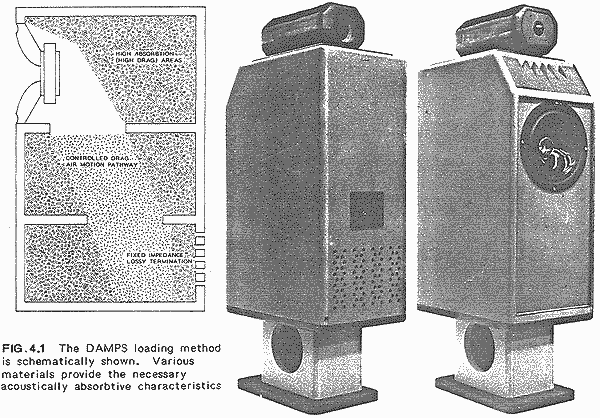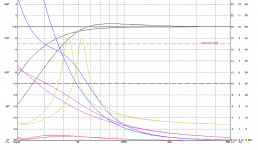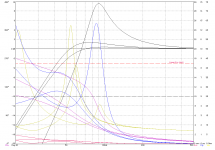What software do you recommend other than WinISD?A few more decibels of output at 20hz going up to about 1db at 50hz. So basically more output at the low end.
The best way to see what's going to happen is to download some software and have a play.
I'm a pretty decent woodworker, my pops is a master, together we can basically build anything out of wood.
We've built a few speaker cabinets for friends based off proven designs and I've always wanted to understand the how and why of diy speaker design. So here I am.
Other than nostalgia, the main reason I chose the A26 kit for my first personal build was the simplicity. I also thought the well behaved nature of the 10" would allow me to play with different cabinet designs and sizes.
Then a friend came along and wanted to trade me some tube gear + cash for the finished A26 speakers. Now he wants me to build a large sealed cabinet but I'm hesitant to build an unproven $1k+ cabinet for $700 worth of drivers.
Now I'm trying to decide whether to build the A26's for myself, build him whatever cabinet he wants and get myself a different kit, or order another A26 kit and build matching cabinets, or build 2 different designs and keep the one he doesn't want for myself.
I use THIS.
I personally like larger drivers, so if it were me I'd build the A26, but I'd keep the baffle dimensions and driver positions exactly as Seas intended. Changing things will most likely mess with the crossover. You can extend the depth of the cabinet though.
Where you could experiment is with a CLD cabinet (constrained layer damping). And CLD type bracing to reduce cabinet resonances.
Also, if you find the bass a bit lacking with an enclosure of 28ltr (I know I would), you could build something around 60ltr and put a port in it tuned to about 22hz. The DeVore 093 is in a similar sized enclosure but ported at 34hz. That would produce a hump at around 60hz (bad place IMO), so I assume the Devore driver is either modified, uses a ton of stuffing inside to lower the peak, or has an overblown, thumping bass.
I personally like larger drivers, so if it were me I'd build the A26, but I'd keep the baffle dimensions and driver positions exactly as Seas intended. Changing things will most likely mess with the crossover. You can extend the depth of the cabinet though.
Where you could experiment is with a CLD cabinet (constrained layer damping). And CLD type bracing to reduce cabinet resonances.
Also, if you find the bass a bit lacking with an enclosure of 28ltr (I know I would), you could build something around 60ltr and put a port in it tuned to about 22hz. The DeVore 093 is in a similar sized enclosure but ported at 34hz. That would produce a hump at around 60hz (bad place IMO), so I assume the Devore driver is either modified, uses a ton of stuffing inside to lower the peak, or has an overblown, thumping bass.
… you could build something around 60ltr and put a port in it tuned to about 22hz...
Not bad. (In theory) i could take the 70 litre box and add a miniOnken style vent that would push the bump down such that the response would tend towards the flatter 1 (140 litre tuned to 22Hz) i have shown.
dave
Attachments
The “XO” in the A26 takes no consideration of box shape.
dave
The Seas A26 driver works well on the baffle that Seas recommend, and doesn't need a crossover or response shaping circuit on the woofer side, but when you change the driver positions on the baffle or change the baffle size, you change the frequency response.
Download The Edge or Baffle Edge Diffraction Simulator and model the A26 baffle, then move the drivers around (model the woofer and the tweeter) and see what happens to the frequency response. Obviously you're going to see a very wonky frequency response unless you model a huge baffle. What you need to look for is relative differences in the frequency response.
I know for building my own speakers that a decibel here and a decibel there, may not look like much on paper, but can make a lot of difference.
I have updated the link to the latest revision planset in Post#51
Seas A26 Devore Style Build
Please post here with QC.
dave
Seas A26 Devore Style Build
Please post here with QC.
dave
Could a shallow, stuffed port tube with the same area as the aperiodic slot vent be used?
It might would be easier to adjust the stuffing amount in a tube vs the slot vent?
We had thought about building a removable plate to cover the front and rear of the slot to allow adjustments in the amount of stuffing material.
It might would be easier to adjust the stuffing amount in a tube vs the slot vent?
We had thought about building a removable plate to cover the front and rear of the slot to allow adjustments in the amount of stuffing material.
I bought the A26 drivers last year and installed them in an advent legacy cabinet. Sounds way better than I would have expected. Incredibly smooth though the low end leaves something to be desired. I have always planned on building my own purpose built cabinets at some point. Now that I am seeing this thread--wow, inspiring. Summer project I guess. Thanks so much for posting all of the plans. I'm still a total novice but gaining ground rapidly thanks to this community.
the low end leaves something to be desired.
Simply adding a 2" diameter x 6" port could fix the problem.
Last edited:
Regarding the large advents - About the flattest and most extended response I can model is with a 6" diameter port about 4" long - and the cabinet stuffed as much as possible to reduce the slight hump you get with a higher tuning frequency. There obviously needs to be a clear path from the driver to the port for the port to work properly. This is all assuming the enclosure is around 50ltrs.
2" diameter x 6”
6" diameter port about 4” long
The first makes sense, the second doesn’t. The third sim is sealed.
Like all but the 70 litre sealed the A26 in the Large Advent is a bit peaked. FatMarley’s venting gives a bit more extention, but with a bump before roll-off.
This places it on the spectrum between the 28 litre A26 box up to the 66 litre CGR.
So it could also benefit from a bit of aperiodic loading, a highR vent might be enuff.
dave
Attachments
My advent legacy boxes are probably about 50 liters if I recall correctly.
I'm curious though about the larger box idea--what trade offs are there in terms of speed? I recall that the A26 engineers suggest their dimensions as it allows the best compromise between low freq and speed/tightness of bass. Forgive me if this is kind of novice question but if the driver is allowed to operate in a larger box, presumably the driver will be less restricted in its movement (acting as a looser spring) and thus lose a certain degree of speed?
I will no doubt find out for myself as I experiment but just curious.
I'm curious though about the larger box idea--what trade offs are there in terms of speed? I recall that the A26 engineers suggest their dimensions as it allows the best compromise between low freq and speed/tightness of bass. Forgive me if this is kind of novice question but if the driver is allowed to operate in a larger box, presumably the driver will be less restricted in its movement (acting as a looser spring) and thus lose a certain degree of speed?
I will no doubt find out for myself as I experiment but just curious.
Speed? Just means the box/driver can do higher frequencies.
In terms of start/stop the best enclosure in that respect would have critical Q (ie 0.5), which would be a sealed box of about 250 litres. But one needs significant room gain to get flattish bass response.
Everything is a trod-off, something like the SEA-Ken with added aperiodic damping will have somewhat similar extention, with good start/stop but at a much more manageble size.
You want a big box. do the TL — Scott & i will likely eventually do an ML-TL (it should be better).
http://p10hifi.net/tlinespeakers/FAL/box-plans/classicTL-revisited-WD.pdf
dave
In terms of start/stop the best enclosure in that respect would have critical Q (ie 0.5), which would be a sealed box of about 250 litres. But one needs significant room gain to get flattish bass response.
Everything is a trod-off, something like the SEA-Ken with added aperiodic damping will have somewhat similar extention, with good start/stop but at a much more manageble size.
You want a big box. do the TL — Scott & i will likely eventually do an ML-TL (it should be better).
http://p10hifi.net/tlinespeakers/FAL/box-plans/classicTL-revisited-WD.pdf
dave
The first makes sense, the second doesn’t. The third sim is sealed.
I should have written 2" diameter x 4"
6" diameter is massive!
FatMarley’s venting gives a bit more extention, but with a bump before roll-off.
Add plenty of stuffing, or an aperiodic vent, and the bump goes away.
2x4 works but not as well as 2x6.
Yes, losing the bump is the whole point of the aperiodic vent. What we have is a range of boxes from 28 (A26) litre to 66 litre (SEA-Ken) with decreasing bump, making the job of tamng it easier.
This is one of the most advanced aperiodic boxes with a bit different kind of vent implementation, but it shows the path idea.

dave
Yes, losing the bump is the whole point of the aperiodic vent. What we have is a range of boxes from 28 (A26) litre to 66 litre (SEA-Ken) with decreasing bump, making the job of tamng it easier.
This is one of the most advanced aperiodic boxes with a bit different kind of vent implementation, but it shows the path idea.
dave
- Home
- Loudspeakers
- Multi-Way
- Seas A26 Devore Style Build

